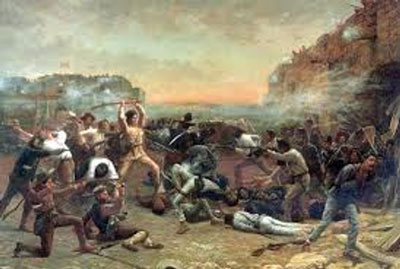
March 6 is a special day in the history of Texas. It marks the fall of the Alamo in San Antonio. For generations Texans have solemnly marked the crucial step in Texas History.
Published by Texas State Historical Association, The Texas Almanac of 2018-2019 presents a succinct, but accurate account of the days leading up to the early morning of March sixth. As more and more Americans settled in the Mexican state of Texas, the Mexican government became suspicious of their intentions. Conferences, Conventions and Consultations tried to settle issues, but the new Texans really wanted control of the vast lands. They wanted to Americanize the region north of the Rio Grande and annex it to the United States. Yet, no worthy of the name government was created by Texans. Sam Houston was named Commander of Chief of the Texas forces with little authority.
On the western edge of the state were several strongholds along the San Antonio River. In January Houston sent James Bowie out to determine if the old mission, the Alamo, was defensible. If not, Bowie was to destroy it and withdraw men and artillery to Gonzales and Copano. On February 8, frontiersman David Crocket and twelve men from Tennessee arrived to aid the revolutionary forces.
Four days later, Mexican president Santa Ana and his army crossed the Rio Grande headed for San Antonio. In the meantime, “governor of the Government” Henry Smith sent William B. Travis to San Antonio. Immediately a split in command of the Alamo garrison arose. Travis and Bowie were not calm, thoughtful men. Most of the men supported Bowie and Houston. Travis agreed to share the command of the roughly 150 men.
Arriving along the San Antonio River around the old mission, Santa Ana hoisted a blood-red flag, the traditional Mexican symbol of no quarter, no surrender, and no mercy. Travis and Bowie responded to the display with a cannon shot. The Mexican army surrounded the Alamo and constantly harassed the Texans with bombarding artillery pieces. Santa Ana planned the continual din in an attempt to destroy the Texans’ moral.
On February 24, Bowie became ill and relinquished his share of the command to Travis. No Texans were killed in the constant fire. They conducted several forays outside the walls to burn buildings hiding Mexicans and to gather firewood. Messengers made it through the Mexican forces. Thirty-two more reinforcements arrived from Gonzales to aid the Texans.
By March 5, Santa Ana had 4,000 men in camp, enough he felt to subdue the Alamo. At that point Travis informed the men of the bleak outlook. All but one vowed to stay and fight. At 6:00 AM in the morning of March 6, Santa Ana led his army to assault the Texans. Between 8:30 and 9:00 that morning fighting halted. All defenders were dead.
While Bowie disobeyed orders and stayed to fight in the Alamo, his decision gave Houston time to recruit more men, to move eastward to an open space along the San Jacinto River and attack Santa Ana and his men during their siesta.
If you would like to know more, I suggest Three Roads to the Alamo by William C. Davis.
